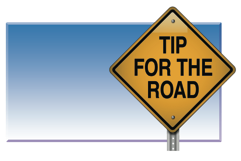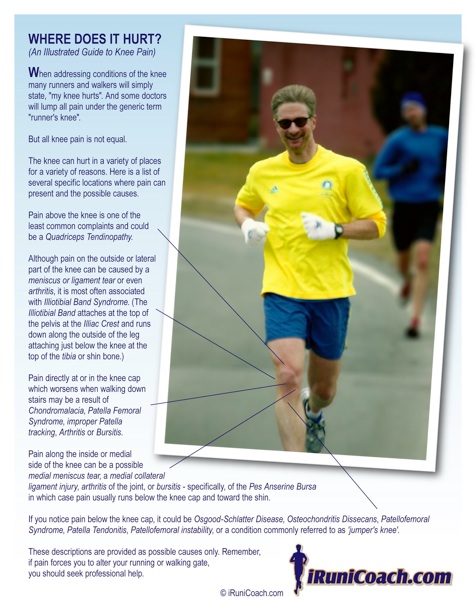running coach marathon training personal training running advice online coaching injury prevention injury treatment how to train for a marathon how to run a marathon training advice marathon runner boston marathon philadelphia marathon 100 marathons long distance running

Bad Knees
I want to address the knee because so many people avoid walking and running for exercise because they believe they have "bad knees". And while some of these people may have been diagnosed with an actual injury or medical condition, many just assume their knees are 'bad' because they feel pain whenever they attempt to run.
Often when starting a running or walking routine, beginners tend to "over-stride", hyper-extending the knee and actually putting on the brakes with each step. In turn, their knees absorb most of the impact and the result is pain. Instead of bad knees, what they may actually have is bad running form.
Barring any medical conditions, incorrect or 'bad' form is the cause for a lot of knee pain.
Reduce impact to your knees by correcting your running form.
The most common error to runners' form - especially beginner runners, is over-striding. In an effort to run faster, they tend to throw their leg out in front and catch themselves with each step. This dramatically increases the impact force of each footstrike. And it causes the knee to act as a shock absorber. It's also why many believe their knees are too bad to run.
Instead, a runner's foot should make contact with the ground when it is almost directly beneath the body. The runner should then propel themselves forward by pushing off and back. This will drive the body forward with less impact for each stride as well as aid in proper placement of foot; reducing heelstrike.
Rather than focusing on stride length, most runners should increase their cadence. Runners (and walkers) should cover more ground with a shorter stride and faster turnover.
And while runners should try to run "tall", there should also be a very slight forward lean which comes from the ankles - never from the hips or lower back.
Immunity
(Tips to avoid catching the cold or flu)
If you want to avoid catching a cold or getting the flu this season, you may be interested to know that studies have shown 30 to 45 minutes of moderate daily exercise - like running or walking - can strengthen the immune system.
But more is not always better. There is a diminishing return as running very long distances can weaken the immune system. This explains why so many marathon runners develop colds or upper respiratory infections in the days following their big race.
A runner is most vulnerable to infection for up to 72 hours after a race or extremely hard effort. This is because the body produces the stress hormone cortisol during exhaustive workouts. And cortisol suppresses the immune system.
So in addition to all the usual common sense practices like regular hand washing, avoiding potential exposure to germs, eating right and getting adequate rest, if you're a runner attempting to outrun an illness, it's probably best to kept your mileage down and the intensity low.
Stay Well
(Tips to boost your immune system)
As mentioned above. 30 to 45 minutes of moderate daily exercise - like running or walking - can strengthen your immune system and help prevent you from getting sick. So get off the sofa and out from under your Snuggie. A daily run or walk won't hurt you.
And there are a few other things you can do in conjunction with running and walking which can also help you stay healthy. There is evidence you can boost your immune system and reduce your risk of catching a cold if you consume an electrolyte replacement drink immediately after your run. Just be sure to opt for the low or zero calorie drinks to avoid weight gain.
And here's one more suggestion…get a massage. A massage can help you stay well by increasing blood flow which will also increase the circulation of infection-fighting white bold cells.
If despite your best efforts you do find yourself ill, it's important to know when you can safely run and when it's best to simply rest. So here’s how to use your head when making that choice...
Heads Up
(How to know if it’s safe to run when you’re sick)
No matter how careful you may be there's a good chance you will eventually catch a cold or get the flu.
If you're trying to decide whether to run when sick, use the 'Above the Neck / Below the Neck' rule.
If your symptoms are above the neck like runny nose, sneezing, or a sore throat, it's probably safe for you to go for a run. Be sure to take it easy and keep the intensity low. And stop running if you experience dizziness, nausea, profuse sweating, or any other acute symptoms.
If the symptoms from your illness are below the neck and include such conditions as chest congestion, deep coughing, vomiting, or diarrhea, do not attempt to start running again until your illness has run its course. Running with some of these symptoms dramatically increases dehydration and can lead to more serious conditions. And never run if you have a high fever or if your doctor advises you not to run.
Taking off a few days until you feel better won't cause you to lose much fitness. It takes longer than that - usually two to three weeks or more.

"In this section I have posted text from articles related to the runner’s and walker’s body. If you have a specific question you would like me to address, send me an email.”
Mark Sullivan
You can reach me by e-mail here:

© 2024 iRuniCoach.com
Black Toenail
If you run long enough (whether by distance or time), you may eventually develop a condition known among runners as, "Black Toenail". But don't be alarmed. Black toenails are actually quite common among runners - especially long-distance runners.
Most doctors, podiatrists, and even shoe salesmen will tell you the condition is caused exclusively by wearing shoes that are too short. However, black toenails can also occur when toes are stressed by excessive flex-at-ion or when nail-related trauma occurs.
So what is Black Toenail?
Basically, it's a blood blister that forms under the nail; the extra blood and fluid cause the toenail to separate from the nail bed and the blood under the nail appears black.
When this occurs, it's best to leave it alone, as long as the pain is manageable. Any pain is usually worst the first day and then lessens each day. The damaged nail is gradually pushed off, as a new nail replaces it. Don't force the old nail off. If at any time you notice severe swelling or infection, see a doctor.
Treating Black Toenail -
The condition known as "Black Toenail" - which is most common among long distance runners - is basically a blood blister that forms under the nail and makes the toenail appear to be black.
It is best to try to ignore this the first day to see if the swelling goes down on its own. If it's still painful after a day, then you may want to drain the fluid. If the swollen area is near the edge of the nail, sanitize the area, sterilize a needle, and try to pierce the blister with the needle. Press to drain it, then apply alcohol and an antibiotic cream.
If the swollen area is not near the edge of the nail, you will need to drill through the nail to drain it. Sanitize the nail with alcohol and sterilize a paper clip with a flame. While the paper clip is glowing red, push straight down through the nail to make a puncture to drain the excess fluid. After you've drained the fluid, flush with alcohol and apply antibiotic cream.
If the toe remains swollen and red even after you have drained the excess fluid, see a doctor to ensure it is not infected.
And if you lose the nail, don't worry. It will grow back in a few weeks.
Hip to be Strong
(Exercises to strengthen weak hips.)
Most runners and walkers believe their knees are the most injury-prone part of their bodies. But many running injuries, including some knee issues, are actually the result of weak hips. And if you sit for hours each day at work or in your vehicle, your hips can really suffer. So to help reduce your risk of injury, I will give you a few simple exercises to keep your hips strong.
First is the lateral leg raise. To perform this exercise, lie down on your side. You can rest on your elbow, but you should keep your lower body, from your hip to your ankle, straight and in contact with the floor. Keep your core muscles tight as you lift your upper leg to about 30-45 degrees in smooth, controlled motion. Then lower it. Start by doing a set of 10 reps per side and eventually work up to two or three sets of 10 reps on each side. You can also increase intensity by adding a resistance band around your ankles or by wearing light ankle weights.
Single-leg squats help you strengthen your hips as well as your glutes and quads. Start by standing with your feet hip-width apart and your arms out in front of you. Raise one leg out in front keeping the knee straight. Your hips should be level as you slowly lower into a squat. You don't need to go down too far, but be sure your knee doesn’t roll inward. Keeping your back straight and arms straight out, slowly return to the standing position. Start with only two or three squats, and gradually build up to 10 reps on each side.
Hip hikes work well to correct muscle imbalances, and should be performed on a step. It may help to do these in front of a mirror. Stand on your left leg with your pelvis in a neutral position, then drop the right side of your pelvis so it’s a few inches lower than your right hip. Using your left hip muscles, lift your right hip back to the neutral position. Start with one set of 10 reps per side and work your way up to three sets on each side.
Self-Treatment for a Sore Calf
Although they may not seem as important as your quadriceps or hamstrings, the muscles in your lower leg play a big role in your running and walking. The calves are actually made up of six muscles, with the gastrocnemius being the most noticeable. This muscle is prone to cramps and spasms, and can quickly go from a tender calf to an angry charlie horse.
If you suffer from overly tight or chronically sore calf muscles try this...
Lying on your back, bend one knee approximately 90 degrees while keeping your foot flat on the ground.
Cross your other leg over the bent leg so the calf muscle of that upper leg is positioned on the knee of the bent leg.
Allow the weight of the upper leg to push the calf muscles into the knobby part of the knee.
Gently move that crossed leg around until you come to a sore spot in the calf, then allow it to rest there until the tension releases.
Even if you hadn't noticed any pain before, you may be surprised just how tight and sore your calf muscles are.
This technique should help.
iRuniCoach.com “Body Shop”...
This section provides information pertaining to the body including self-treatment techniques and help for nagging injuries. Many of the articles below are taken from the texts of Mark’s weekly radio segment entitled “Tip For The Road”.
(The insert below entitled “Where Does It Hurt” can be viewed and downloaded as a .PDF by clicking on the image.)
Iliotibial Band Syndrome
Ever hear of Iliotibial Band Syndrome? It may sound like the title of a 1970s album from a psychedelic rock group, but it's actually a relatively common ailment for runners and serious walkers.
The Iliotibial Band is a thick band of connective tissue that runs along the outside of the leg from the top of the pelvis (or iliac) to top of the shin bone (or tibia), attaching just below the knee. The band works with the thigh muscles (or quadriceps) to provide stability to the outside of the knee.
Iliotibial Band Syndrome, is a common cause of pain on the outer (or lateral) side of the knee, but may also be felt near the hip. Pain is most often felt as the Iliotibial Band rubs over the outside of the knee. This is the IT Band's normal function, but it can produce pain when stressed.
If you feel pain on the outside of your knee or soreness when you press against the side of your leg, you may have or be developing Iliotibial Band Syndrome.
Causes of ITBS -
Although Iliotibial Band Syndrome is most commonly caused by training errors, it is often seen in runners performing unbalanced, repetitive exercise like running on only one side of a crowned road. Because most roads are sloped on the sides, running along the edge causes the outside foot to be lower than the inside foot, and this can cause the pelvis to tilt to one side - stressing the IT band. The same thing can happen when running only one way around a track.
Biomechanical abnormalities may also lead to IT band problems. These could include: excessive pronation (or inward roll of the foot), leg length discrepancy, or legs which are 'bowed", and lateral pelvic tilt. Muscle tightness or lack of flexibility in the gluteal or quadriceps muscles may increase the risk of Iliotibial Band injuries.
Treatments for ITBS -
Like so many running-related injuries, the most often recommended treatment for Iliotibial Band Syndrome is the R.I.C.E. method. (R.I.C.E. is an acronym for rest, ice, compression, and elevation.) Rest is a relative term and can include active rest with a reduction of activity.
NSAIDs or non-steroidal anti-inflammatory drugs (like ibuprofen) may also be used to reduce pain and inflammation.
The IT Band responds well to ultrasound. So a physical therapist may use ultrasound and other modalities to help the injured tissues heal more quickly.
One of the newest and most effective self-teatment methods involves myofacial release of the tissue through the use of a foam roller. And although it can be very painful, many runners achieve excellent results with this technique.
Preventing ITBS -
Even more important than knowing how to treat Iliotibial Band Syndrome is understanding how to prevent it!
So here a few tips to prevent chronic ITBS…
- First and foremost: avoid overtraining! That includes getting adequate rest.
- Cross train and avoid sudden changes or increases in your training.
- Make sure you're wearing the correct type of running shoes for you and replace them regularly. Consider orthotics if necessary.
- A knowledgeable coach or sports physical therapist may be able to uncover biomechanical problems and make corrections in your technique.
- Strengthening the external muscles of the hips and quadriceps can help reduce the risk of IT Band injuries. Try backwards running to correct muscle imbalances and reduce pressure on the knees.
- If you have a chronically tight IT Band, regular stretching and use of a foam roller may help reduce tightness and prevent irritation.
- And finally, try running on a soft, level surface and alternate directions on the road.
With a little prevention, Iliotibial Band Syndrome doesn't have to be a chronic, debilitating problem.
Toe Lift
(The proper stretching technique for calf muscles)
There's an very old saying, 'if you lift the calf everyday eventually you will lift a cow'.
Few of us have hopes of lifting a cow, but many runners do struggle with their calf. Calf muscles that is.
And most runners stretch their calf muscles incorrectly.
It's ironic because the static stretch they do actually puts pressure on the calf, which responds by tightening up even more.
Instead of doing the traditional calf stretch which looks like you're trying to push down a wall, lift your toes - everyday.
Stand with your body weight resting on one foot.
Keeping the heel of the other foot on the ground, lift that foot's toes up and back toward your shin.
Hold for a two or three seconds, then release.
Repeat 10 times, and each time try to lift your toes closer to your shin. Then do your other leg.
If despite your best efforts you still have chronically tight calf muscles, there is a simple self-treatment you can do to help eliminate soreness and reduce tightness. (See “self-treatment for a sore calf” article in right column.)

